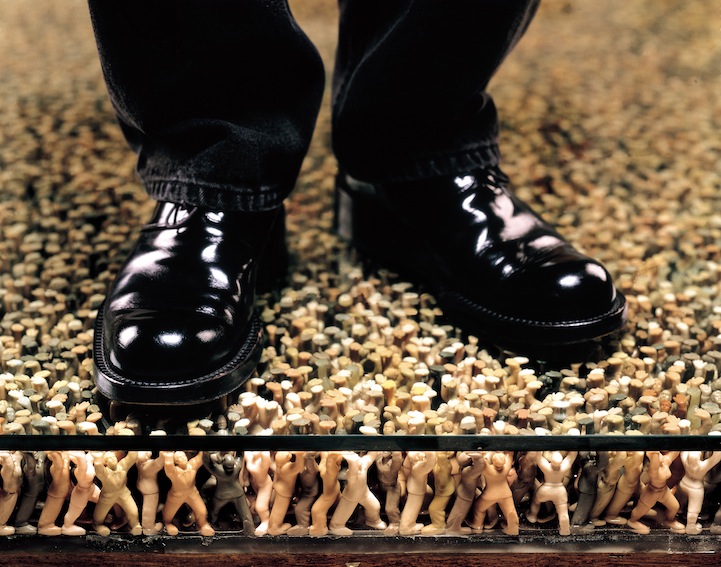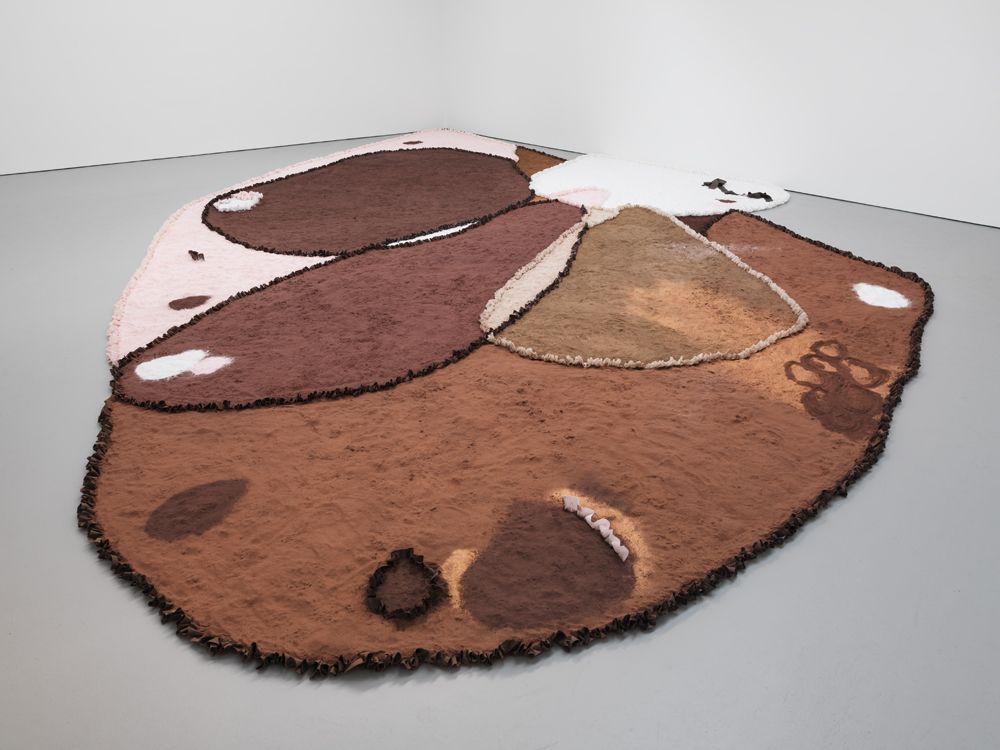Worlds of water swirls, cosmetic products and tiny plastic figures. Our personal top ten contemporary floor pieces.
Decorating the floor is an art form almost as old as humanity itself, the earliest mosaic dates back 400,000 years. Since then, the Greeks did it, the Romans did it, as well as the Middle Eastern World. Floor art can take various forms and shapes, from mosaics to carpets to paintings and sculpture, from simple patterns to naturalistic portraits to chalk drawings.
1. Haerizadeh, Haerizadeh, Rahmanian, O You People!, 2020
The center piece of the first German solo exhibition of the Iranian artist collective Ramin Haerizadeh, Rokni Haerizadeh and Hesam Rahmanian at the Schirn is “O You People!”, a site-specific monumental floor painting. To create this immersive environment, the artists transform themselves into dastgāhs, an old Persian term for an entire set of tools needed for a specific task or the melodic matrix for improvisation in traditional Persian music.
Tools for the artists’ work include: Big ears, to listen closely to the current of time; dresses, to include a female perspective; life vests, to connect to the migrants fleeing across the Mediterranean Sea. Armed with painting machines, the dastgāhs always follow the same ritual to create the basic structure of the piece. Afterwards the artists add numerous details in a more traditional way, creating a fascinating landscape, including huge water vortexes, oriental patterns, and carpet-like surfaces. In short: a maelstrom of stories overloaded with references from ancient to contemporary.

2. JR, A Walker In The City, 2015
In 2015, on assignment for The New York Times and their “Walking New York” issue, photographer and street artist JR installed “A Walker in the City”, a large-scale pasting of a young man in the triangle just below the Flatiron Building, right where 5th Avenue and Broadway cross each other. Comprised of 62 pieces, 20 people assembled the black and white photography print of 20-year-old Brooklyn waiter Elmar Aliyer who immigrated to NYC from Azerbaijan, keeping with the interest of JR in migration, human connection, community, and identity.

3. Zuzanna Czebatul, Vortex (A New Day Coming), 2020
Inspired by the opus sectile technique popular in ancient and medieval Rome were materials are cut and inlaid in floors and walls creating patterns, Czebatul created her very own opus sectile floor out of concrete and pigments with the patterns referencing the architecture of the Centre d’art contemporain – La synagogue de Delme in France, a former synagogue turned into a contemporary art space. The Torah ark, the windows, as well as the columns at the entrance are translated into almost fluid like patterns gravitating to a dark vortex in the middle of the room, simulating the passing of time and the eternal movement of sand deserts.

Zuzanna Czebatul, Vortex (New Day Coming), 2020, installation view, CAC-La synagogue de Delme, 2020. Courtesy: the artist; photograph: OH Dancy, Image via passe-avant.net
4. Imran Qureshi, And How Many Rains Must Fall before the Stains Are Washed Clean, 2013
In 2013, visitors of the Metropolitan Museum’s roof top in New York were confronted with a special view: blood red splatters covered the concrete floors and railings, instantly raising the question: who was murdered up here? On closer inspection, patterns emerge. Hundreds of petals, flowers bloomed out of the chaos. That year’s roof top commission was created by Pakistan-born artist Imran Qureshi who started using red acrylic paint in his installations after the brutal bombings started in Lahore in the early 2000s. Instead of just confronting the audience with the violence of his birthplace, though, he introduced new life growing out of the destruction–a new beginning and the hope of a fresh start.

Imran Qureshi, And How Many Rains Must Fall before the Stains Are Washed Clean, installation view, 2013, acrylic, COMMISSIONED BY THE METROPOLITAN MUSEUM OF ART, NEW YORK, Image via www.artnews.com
5. Anish Kapoor, Descension, 2017
After installations in India and the palace garden of Versailles, Anish Kapoor’s “Descension” made it to Brooklyn Bridge Park in 2017, as part of the Public Art Funds’ 40th anniversary. A body of water continuously swirling in a vortex motion towards a center, for “Descension” Kapoor not only uses the ground as a canvas, but quite literally descends through it into the unknown. By leaving the water a natural blue, different than in India and France where he dyed it black, he created a deeper connection to the East River that runs directly next to Brooklyn Bridge Park.

Anish Kapoor, Descension, Brooklyn, 2017, Image via WikiCommons
6. Polly Apfelbaum, Flatterland: Funkytown, 2012
New York City-based visual artist Polly Apfelbaum is known for her floor pieces she calls “fallen paintings”. Her pieces often fluctuate between structural and formless. “Flatterland: Funkytown“ was no exception: a splatter of crushed synthetic velvet pieces, all hand-cut and dyed by the artist, was arranged across the floor by chance and at the same time structured by color, line, and form. The work was named after 19th century novel “Flatland: A Romance of Many Dimensions” by Edwin Abbott Abbott and 2001 “Flatterland” by Ian Stewart, both novels describing a two-dimensional world where social hierarchies are flattened to forms and shapes.

Polly Apfelbaum, Flatterland: Funkytown, 2012, Image via www.dameliogallery.com
7. Do-Ho Suh, Floor, 2000
Visitors of the Indianapolis Museum of Art were encouraged to step onto the slightly elevated glass floor in gallery W403. 32 individual squares perfectly fill out the space from wall to wall. Standing on top, one starts to recognize tiny colorful dots and crouching even closer one can identify them as the hands of thousands of tiny colorful figures, supporting the glass plates above: The collective carrying the one. A recurring theme of Seoul-born sculptor Do-Ho Suh who engages architecture and space with the tensions between collective actions and the individual’s identity in his work.

DO HO SUH, Floor, 1997-2000, Installation at Lehmann Maupin Gallery, New York, Courtesy the artist and Lehmann Maupin Gallery, New York, Image via mymodernmet.com
8. Christo und Jeanne-Claude, Wrapped Floor and Stairway, 1968/69
When wrapping their first public building in 1968, the Museum of Contemporary Art in Chicago, Christo and Jeanne-Claude decided to not only cover the outside with heavy tarpaulin, but also create an accompanying piece on the inside. For “Wrapped Floor and Staircase” they wrapped the floor of the museum’s lower gallery in off-white drop cloth, secured with ropes. Christo and Jeanne-Claude are famous for their wrapped buildings, from the Reichstag to The Pont Neuf. Even though both artists are now deceased, Christo only recently died in May 2020, there will be one more project of the artist couple: “L’Arc de Triomphe, Wrapped” taking place a year from now in September 2021.

Christo and Jeanne-Claude, Wrapped Floor and Stairway, Museum of Contemporary Art, Chicago, 1968-69, Photo: Shunk-Kender © 1969 Christo, Image via christojeanneclaude.net
9. Karla Black, Includes Use, 2016
For her second show at David Zwirner in NYC in 2016, the Glasgow-based sculptor Karla Black created “Includes Use”, an expansive floor piece comprised of, who would have guessed it, colored toilet paper. Black is interested in everyday materials like sugar, soap, or tooth paste which she detaches form their original purpose and transforms into something ethereal, almost mysterious. Starting point for “Includes Use” was a rough chalk drawing on the gallery floor by Black herself that was then filled in with pools of colored plaster and powdered paint. These pools were encircled by delicately ruffled toilet paper in pale pink, light brown, and buff, giving rather the idea of an elegant confectioner’s cake than the ordinary daily life product.

Karla Black, Includes Use, 2016, Image via afasiaarchzine.com
10. Lee Mingwei, Guernica in Sand, 2006/2020
Aus 28 Tonnen Sand gestaltete Lee Mingwei im Juli 2020 die Arbeit „Guernica in Sand“. Hierfür empfand er Picassos ikonisches Gemälde „Guernica“ in der buddhistischen Tradition des Sandbildes nach. Nach der Fertigstellung im Gropius Bau in Berlin durften Besucher*innen der begleitenden Ausstellung über den Sand laufen. Abschließend wurde das Sandbild, so wie es die buddhistische Tradition verlangt, zusammengefegt – im Sinne einer Verwandlung, nicht einer Entfernung. Der taiwanesisch-US-amerikanische Künstler wirft damit die Frage auf wie es nach der Zerstörung weitergeht und thematisiert das Potenzial von Kunst als transformative Kraft.

Lee Mingwei, Guernica in Sand, 2006/2020, Gropius Bau, installation view. Courtesy: the artist and Gropius Bau, Berlin; photograph: Laura Fiorio. Image via artreview.com
UPDATE
The SCHIRN will be closed from November 2 to 30. We’ll be there for you online – with exciting articles on SCHIRN MAG and lots of content on Facebook, Instagram & Co.









